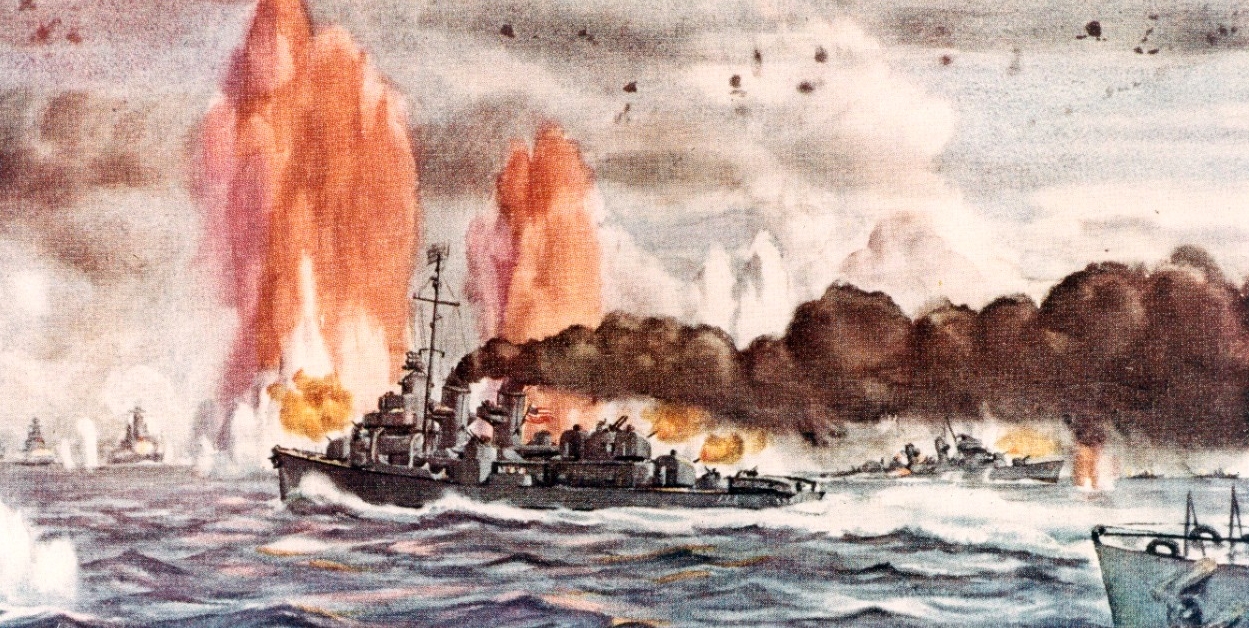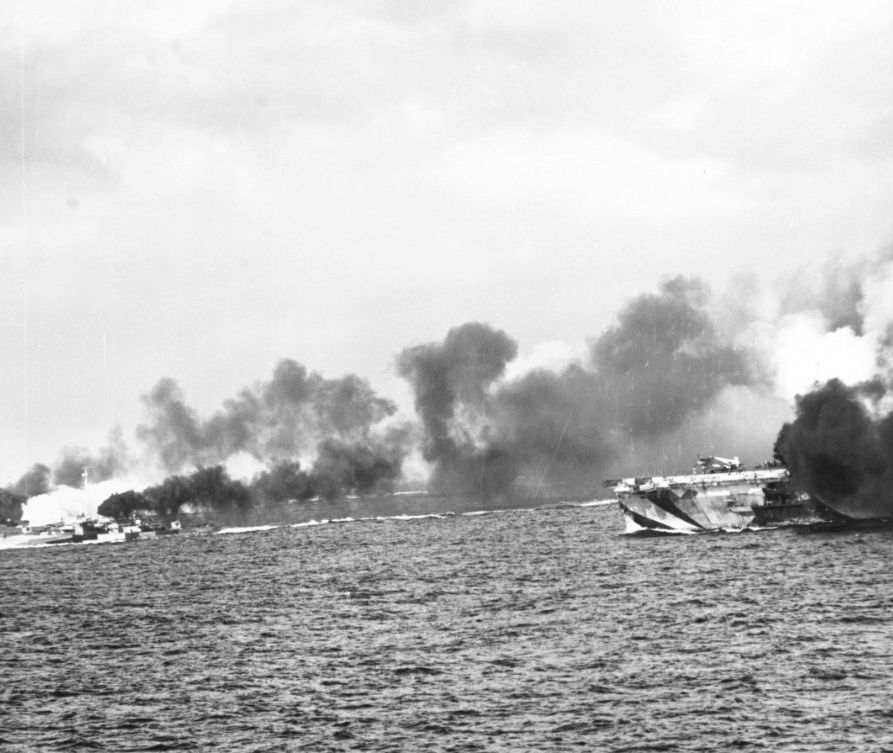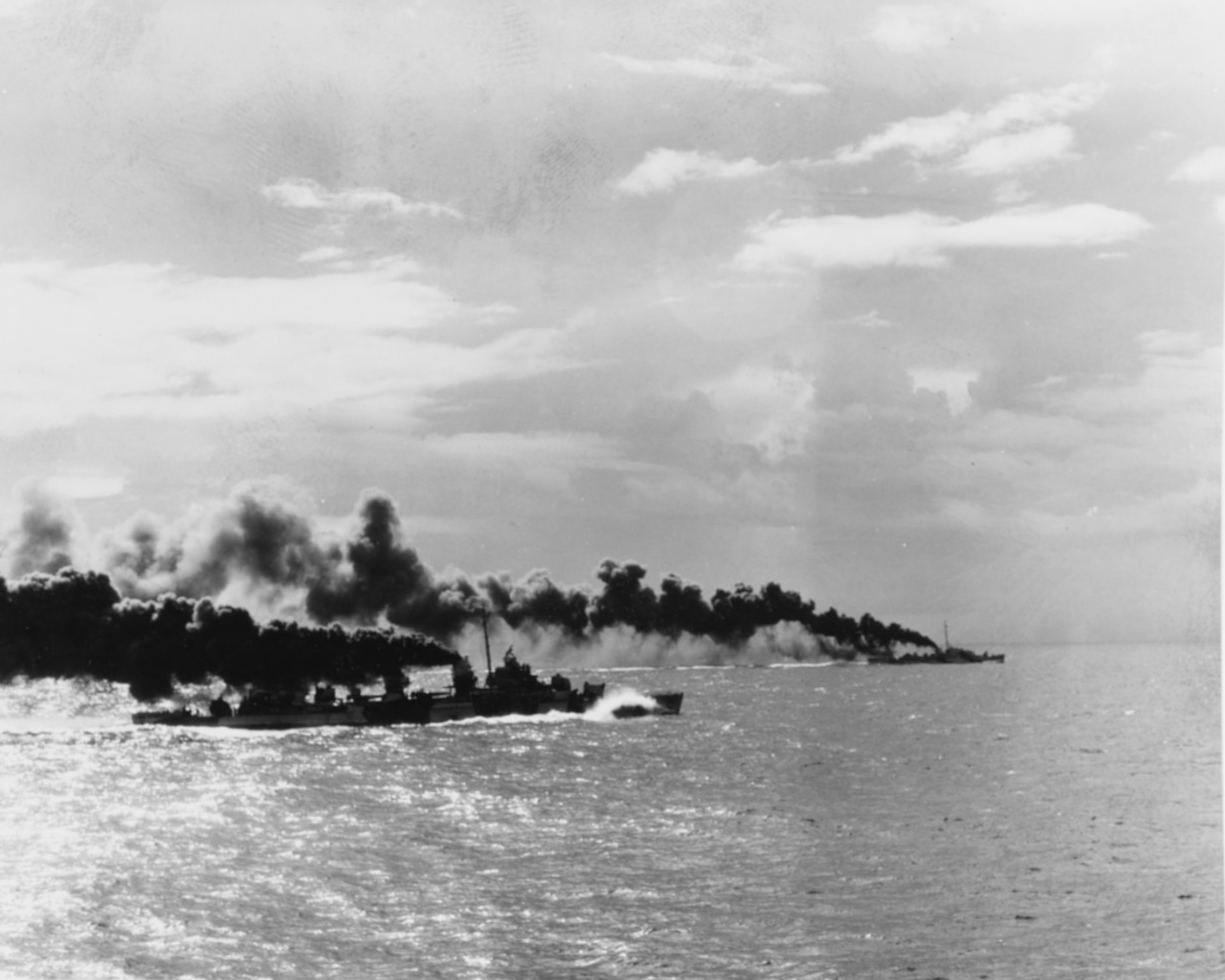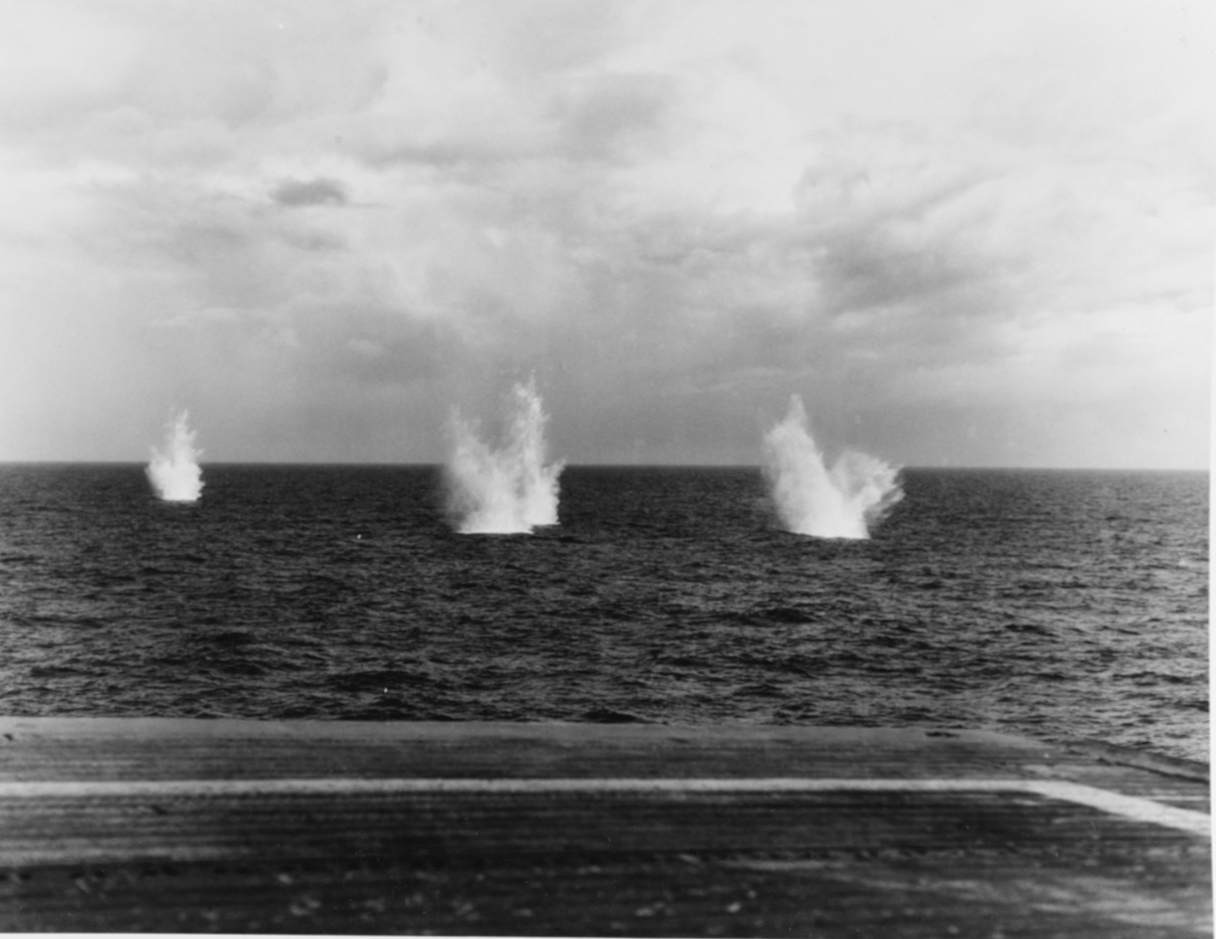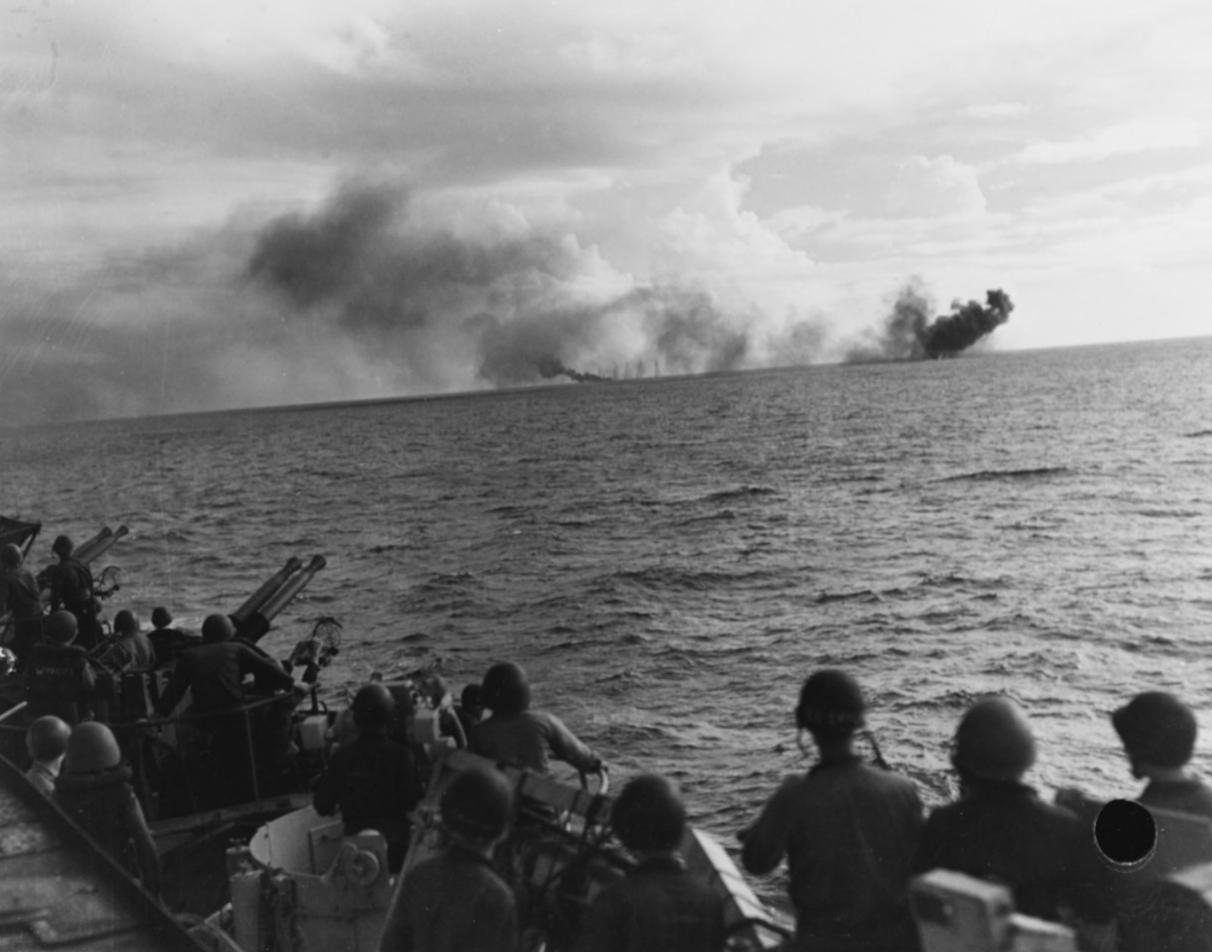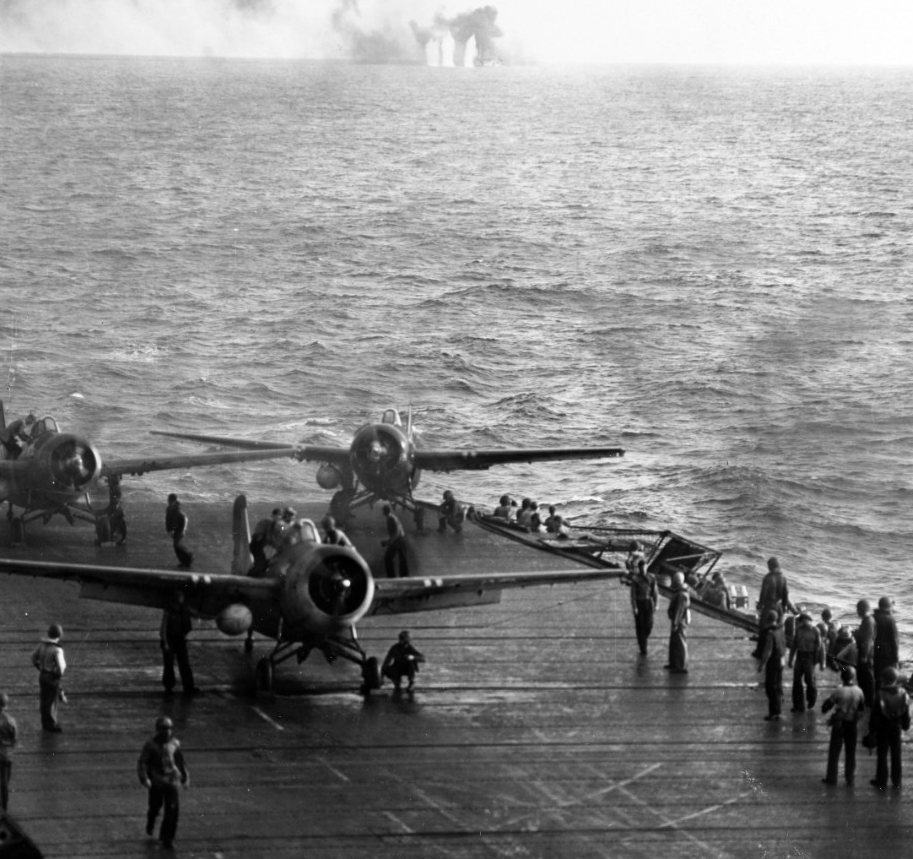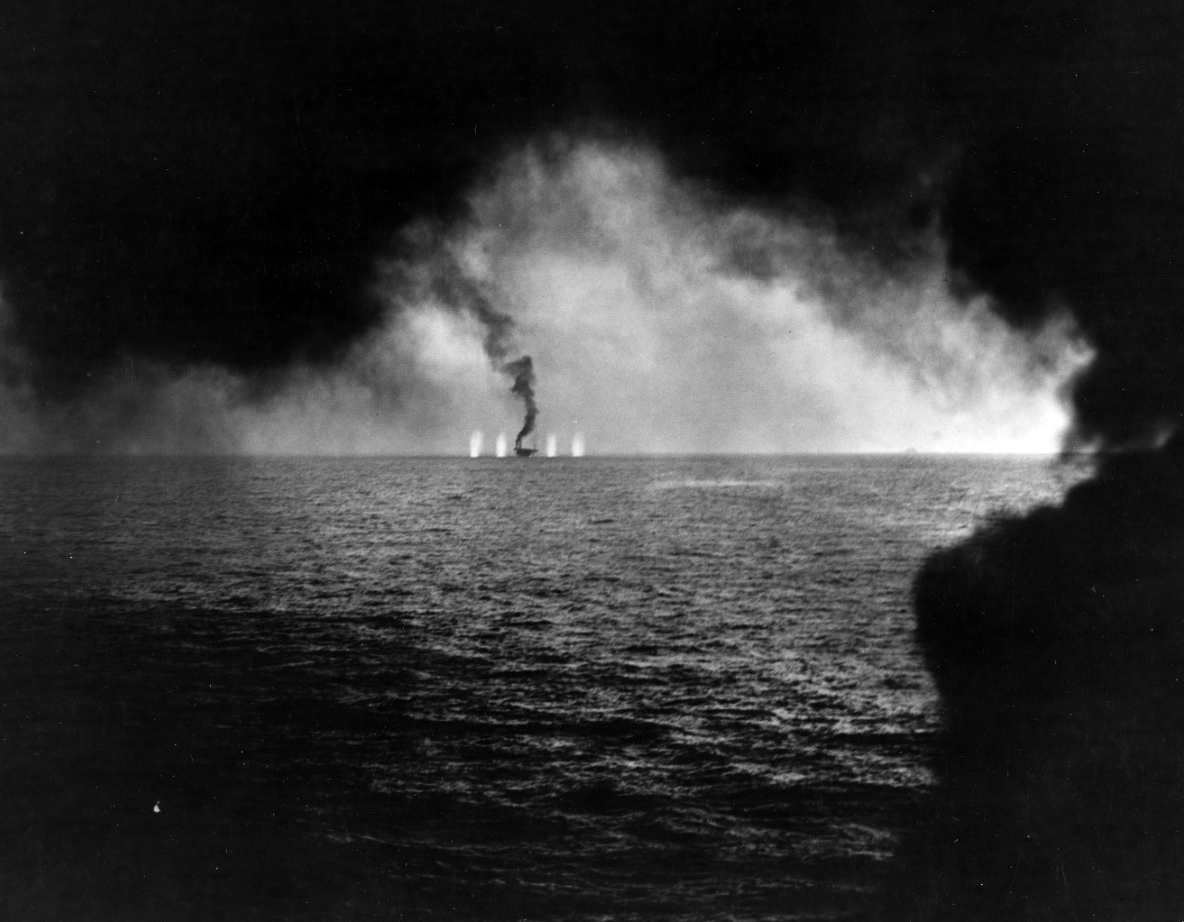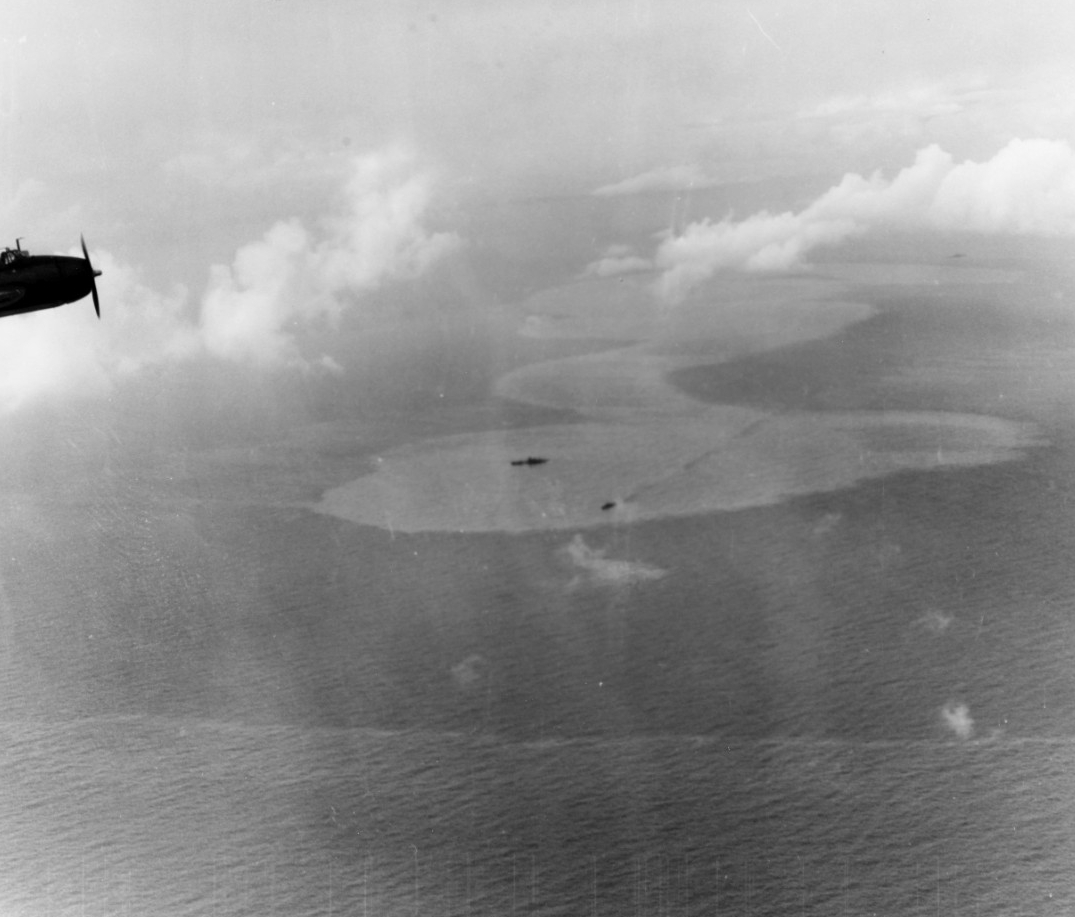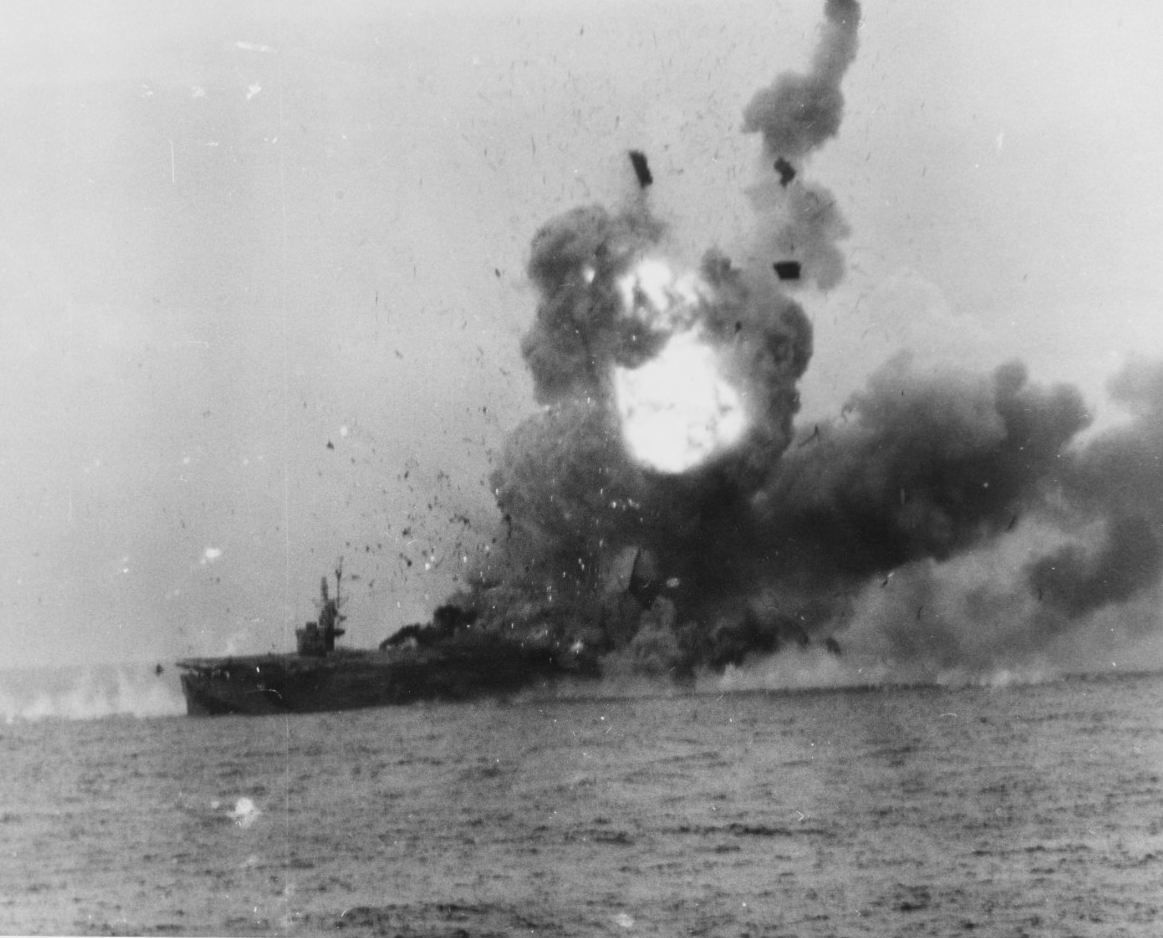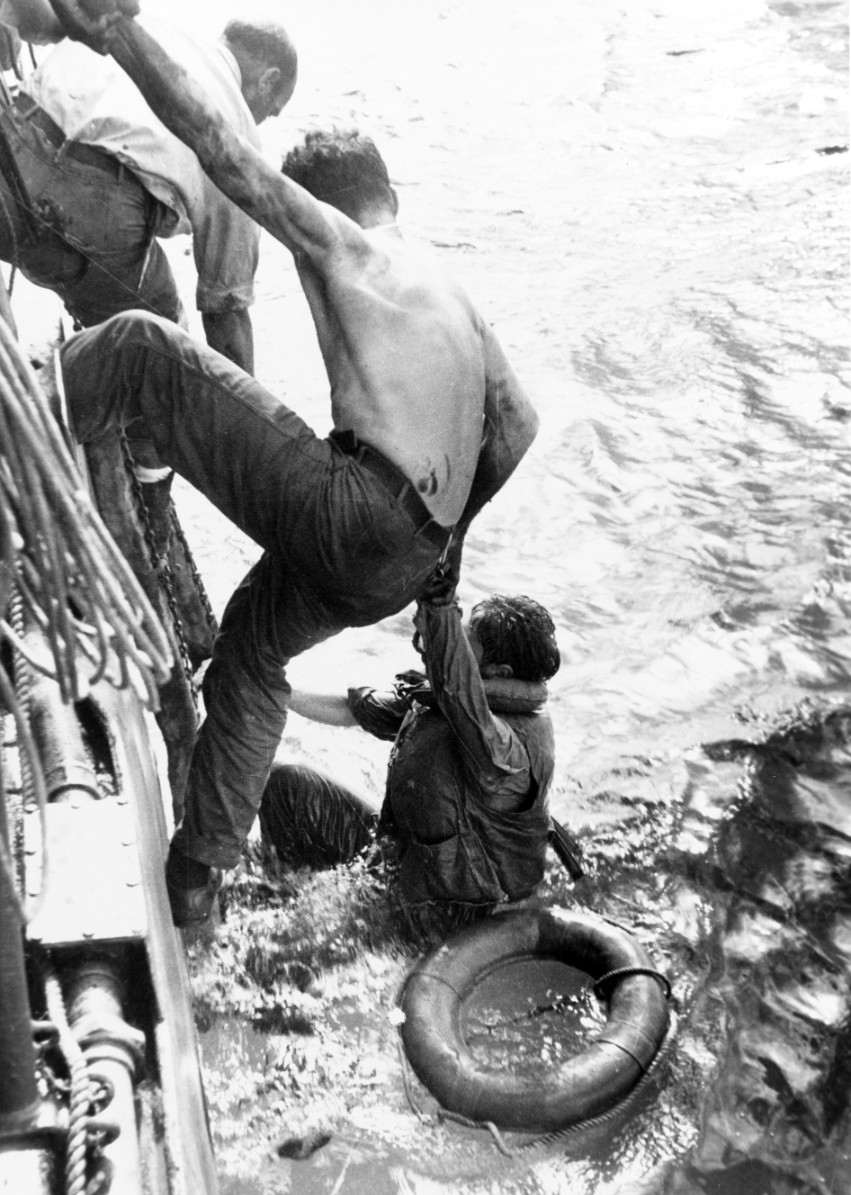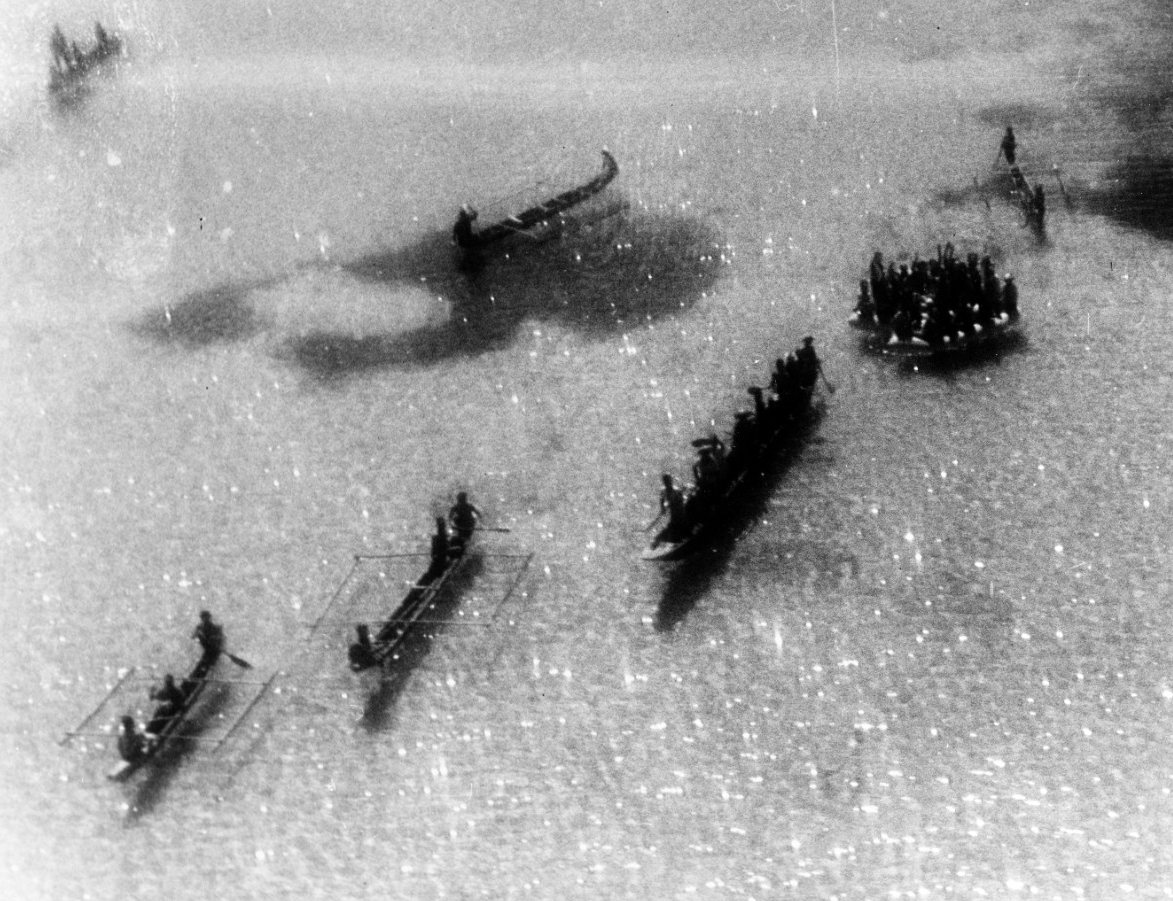The Battle off Samar: The Sacrifice of “Taffy 3”
25 October 1944
Watercolor by Commander Dwight C. Shepler, USNR, depicting an episode during the torpedo attacks by the TG 77.4.3 ("Taffy 3") destroyer screen. Ships present are (left to right): Japanese battleships Nagato, Haruna, and Yamato, with salvo (Japanese shells contained dye for spotting purposes) from Yamato landing in left center; USS Heerman (DD-532), USS Hoel (DD-533) sinking; Japanese cruisers Tone and Chikuma (NH 79033 KN).
Overview
On 15 October 1944, the Japanese Imperial Navy’s First Mobile Fleet launched Operation Shō, a last-ditch attempt to engage Allied naval forces off Leyte in the central Philippines decisively. Following the 24 October Battle of the Sibuyan Sea, the powerful Japanese First Diversion Attack Force (“Center Force”) appeared to be retiring westward. However, the task force ultimately resumed its eastward passage, broke out of the San Bernardino Strait north of Samar early the following day, and headed southward toward Leyte Gulf. The Japanese Northern Force, a carrier task force, had drawn Admiral William F. Halsey’s U.S. Third Fleet to the north. The heavy forces of Vice Admiral Thomas C. Kinkaid’s U.S. Seventh Fleet were engaged to the south of Leyte Gulf. This left only three Seventh Fleet escort carrier (CVE) task units on the northern flank of the Leyte operational area, where they had been providing close air support and an ASW screen for the amphibious landings. Just after sunrise on 25 October, Rear Admiral Clifton A. F. Sprague’s TG 77.4.3—call sign “Taffy 3”—the northwesterly-most task unit, made up of six small escort carriers, three destroyers, and four destroyer escorts, was stunned to confront four Japanese battleships (among them Yamato with her 18-inch main guns), six heavy cruisers, two light cruisers, and 11 destroyers.
Taffy 3 was comprised of the following ships:
Destroyers
Destroyer Escorts
(See images of these vessels in "The Ships of TG 77.4.3")
The Battle
Initial Contact
Following its San Bernardino Strait passage, the Japanese Center Force was still in its nighttime search disposition. At 0623, shortly after sunrise and before the task force had fully shifted to its circular daytime anti-aircraft formation, Yamato made radar contact with U.S. ASW patrol aircraft. Additional air contacts followed and were fired on until 0650, when the Japanese sighted what appeared to them to be a large U.S. task force of carriers and cruisers on the eastern horizon, thought to be part of the U.S. Third Fleet (this was actually Taffy 3). Center Force’s commander, Vice Admiral Takeo Kurita, immediately ordered his ships to move into a pursuit formation. Due to still-ongoing shift from nighttime to daylight antiaircraft dispositions, this order inadvertently led to confusion. It would have the effect of committing the Japanese ships in a piecemeal fashion and dispersing their overwhelming firepower during the upcoming battle.
Taffy 3’s first contact with Kurita’s force was a visual sighting of antiaircraft fire to the northwest, immediately followed by a surface search radar “hit” and intercepted Japanese voice transmissions. Shortly after, Kurita ordered his forces to engage and Yamato, followed by other Japanese ships, opened fire. Later, Taffy 3 personnel were to remark on the brightly colored geysers thrown up by the salvos of near-misses that were caused by the spotting dye added to Japanese shells. By this time, Sprague had his carriers come about and initially followed a southeasterly course. His destroyers generated a smoke screen and, Johnston in the lead, began firing at their pursuers. At this point, Taffy 3’s sister task units, Taffy 1 and Taffy 2 (TG 77.4.1 and TG 77.4.2) were approximately 25 nautical miles to the southeast and had adopted a southeasterly course. Although its escorts were bound to protect the slow, unarmored escort carriers, Taffy 2, commanded by Rear Admiral Felix B. Stump, was able to support Taffy 3 with its aircraft as the battle progressed. Taffy 1, commanded by Rear Admiral Thomas L. Sprague, also launched some aircraft, but would be faced with other challenges as the day progressed.
Sprague also launched fighters and bombers, which, although armed for their original close air support and ASW missions, could at least harass Taffy 3’s pursuers. Sprague also began to change course toward the south; developments would ultimately force him toward the southwest. (Thus, the overall track of the Battle off Samar would come to resemble an inverted fishhook.)
U.S. Torpedo Attacks
At 0716, and again at 0742, Sprague ordered his screen to carry out torpedo attacks. The three destroyers, Johnston (in the lead), Heerman, and Hoel carried out the first. Johnston managed to damage the heavy cruiser Kumano with a torpedo hit, but was heavily damaged by 6- and 14-inch shells. Hoel fired at, and missed, the battleship Kongo, and was also hit multiple times. For a time, she was boxed in by Japanese battleships and cruisers, all of which fired at her. Heerman entered the fray just before Sprague’s second attack order. Heerman launched torpedoes at the Japanese heavy cruiser Haguru, but she evaded them and fired multiple salvos at the destroyer, which all missed. Moving beyond the Japanese cruiser division, Heerman came upon the battleships Kongo, Yamato, and Nagato, firing her remaining torpedoes and 5-inch guns at Kongo. The destroyer then quickly came about and moved to a screening station on the starboard flank of the carriers. Despite the intensity of Japanese fire, the only damage aboard had been caused by shell fragments. The determined, aggressive attacks of the three U.S. destroyers, coupled with the ongoing air attacks on his ships, tended to confirm Kurita’s erroneous assessment that he was facing a strong carrier task force. The second U.S. torpedo attack would only strengthen this impression.
Sprague ordered his screen to make a second torpedo attack shortly after and his destroyer escorts also engaged. Samuel B. Roberts joined Heerman and the badly damaged Hoel; Dennis, John C. Butler, and Raymond followed, attacking individually. The hard-hit Johnston was also back in action. They faced not only a Japanese cruiser division, but also most of the Japanese destroyers. U.S. and Japanese ships zig-zagged, and exchanged intensive gunfire and torpedoes in the melee-like conditions. Johnston was still able to lay such a heavy fire on the Japanese cruisers Haguro and Tone that these reported her as a “heavy cruiser.” By 0820, the U.S. escorts had rejoined the escort carriers, laid smoke, and proceeded on the task unit’s southwesterly course. Shortly after, at 0830, Hoel went dead in the water. Listing to port, with all of her engineering spaces flooded and her No. 1 magazine on fire, Hoel began settling by the stern and her crew abandoned ship.
The U.S. Escort Carriers in Action
Even before Sprague had ordered the initial torpedo attack, the escort carriers found themselves under heavy fire from their pursuers. After the brief rain squall and the U.S. air attacks, Japanese battleships and heavy cruisers were gaining on the carriers from astern and enemy destroyers were approaching from starboard. Moreover, a Japanese heavy cruiser division had managed to overhaul the carrier formation’s port flank, intending to cross its “T” and cut it off. This pushed Sprague toward the southwest and forced him to launch aircraft with the added disadvantage of a following wind. The U.S. aircraft were ordered to target the heavy cruiser division to port of the carriers. Taffy 2, to the southeast, also launched aircraft at Kurita’s force. Center Force would remain under relatively uncoordinated, but heavy, U.S. air attack throughout the engagement.
With its course turning toward the southwest, the escort carriers were taken under Japanese fire from the north and east. As the range was reduced, the carriers began firing the single 5-inch guns under their fantails at their pursuers. Although this fire had little effect on the Japanese, Kalinin Bay and White Plains were actually able to score hits on the Japanese heavy cruisers. (Significantly, a chance White Plains hit on Chokai caused enough damage aboard the latter for her to fall out of formation and later fall prey to aircraft from Kitkun Bay.) More smoke was laid, but given the course and wind direction, this did little to hide the carriers. All were hit by Japanese shells, but the enemy’s gunnery during this phase was not good and the full effect of their armor-piercing shells was wasted on the unarmored U.S. vessels. However, Gambier Bay, on the exposed port flank of the formation, began receiving Japanese hits—including from Kongo—at 0810, which started fires on her flight and hangar decks. She then received hits below the waterline in her forward port engine room, which flooded. This reduced the escort carrier’s speed and she dropped behind the formation. Johnston attempted to draw fire away from Gambier Bay, but the Japanese concentrated on the carrier. Gambier Bay was dead in the water and sinking by 0840 and ordered abandoned ten minutes later.
Kurita Presses the Attack
As the task unit proceeded toward the southwest, Samuel B. Roberts, Heerman, and Johnston continued to engage the pursuing Japanese heavy cruisers. Shortly before Hoel sank, Sprague ordered John C. Butler and Dennis to take up station on the escort carriers’ starboard quarter (where they were joined by Raymond), interposing them between the carriers and the Japanese. At this point, with the exception of John C. Butler, the escorts had expended all of their torpedoes. Given the dispositions of the two forces, it was also questionable if an advantageous firing position was even still possible. The destroyers and destroyer escorts had to resort to darting attacks at the Japanese cruisers while firing their guns, zig-zagging back and forth between the carriers and the enemy. Smoke screens partially shielded Sprague’s carriers, but the escorts were hit hard, yet remained underway and able to fight. Around 0850, Samuel B. Roberts received her first serious hit, which entered her hull under the waterline and knocked out her No. 1 fireroom. More Japanese hits followed. A massive explosion caused by several 14-inch shells tore an over 30 feet–long gash on the destroyer escort’s port side, obliterated the No. 2 engine room, ruptured fuel tanks, and started fires. All power and communications were lost, and Samuel B. Roberts was abandoned at 0910. Her commanding officer, Lieutenant Commander Robert W. Copeland, USNR, was awarded the Navy Cross.
At 0845, just before Samuel B. Roberts' waterline hit, the Japanese light cruiser Yahagi and several destroyers launched a torpedo attack on the Taffy 3, which was repulsed by Johnston’s furious fire and strafing by U.S. aircraft. However, Johnston, limping on one engine, was hit several times more as the Japanese destroyers concentrated their fire on her. Her other engine knocked out, her topsides in shambles, with no power or communications, Johnston was dead in the water at 0945 and was ordered abandoned five minutes later. Johnston’s commanding officer, Commander Ernest E. Evans, did not survive her sinking, but was awarded the Medal of Honor posthumously. The Japanese destroyer squadron’s attack was to be the enemy’s last offensive action.
Japanese Withdrawal
Taffy 3 might not have survived if Kurita’s ships had not been under air attack during the entire Samar engagement. As noted above, Rear Admiral Stump’s TG 77.4.2 (Taffy 2), was particularly engaged in this facet of the battle, augmenting Taffy 3 aircraft over the dispersed Center Force. Earlier that morning, just after the Japanese force had been sighted by Taffy 3, Stump had his available TBM Avengers re-armed with torpedoes or 500-pound bombs capable of damaging capital ships. As Taffy 3 was being pursued, Stump closed the distance to Sprague’s task unit and was able to launch three strikes during the battle’s roughly 90-minute duration. (At one point, Taffy 2 sighted Japanese ships, which, temporarily diverted from their pursuit of Sprague, fired on Taffy 2’s destroyers.) Rather than targeting specific vessels, Stump ordered his air group to attempt to cripple as many Japanese ships as possible. Taffy 2 and Taffy 3 aircraft contributed to the sinking of the heavy cruisers Chokai, Chikuma, and Suzuya, all of which had received some degree of damage from surface action. Additionally, aircraft damaged most of the other Japanese combatants and, combined with Sprague’s smoke screens, adversely effected Japanese gunnery and Kurita’s command and control of his dispersed force. After his last remaining scout aircraft was shot down shortly after 0900, and unaware of the proximity of his weakened and outnumbered opponent, Kurita decided to break off the surface action. Center Force, still under air attack, began to retrace its course toward the northwest.
The U.S. task units were not to have a long respite. Already at 0740 that morning, Taffy 1, in the process of launching aircraft in support of Taffy 3, had been attacked by six land-based Japanese planes from the recently constituted “Special Attack Air Corps,” the first official kamikaze unit. USS Santee (CVE-29) was hit by one, which caused flight and hangar deck fires. Other Taffy 1 escort carriers experienced near misses. The kamikaze attacks—an as-yet-unfamiliar enemy tactic— halted or slowed flight operations until after 1000.
Land-based kamikaze aircraft attacked Taffy 3 just before 1100. Kitkun Bay, Fanshaw Bay, and White Plains shot down or drove off their attackers. However, one Japanese plane, already damaged by White Plains antiaircraft fire, dove into St. Lo. The aircraft, a Mitsubishi A6M Zero (or Zeke), crashed through St. Lo’s flight deck into her hangar deck. The explosions of ready ordnance blew off the ship’s flight deck and elevator; fires raged. St. Lo sank in less than 30 minutes after the attack. Follow-on kamikaze targeted the other carriers. One hit Kalinen Bay’s flight deck, but the resulting fires could be extinguished. Her after stack was also hit. By 1130, the Japanese air attacks ceased and the task unit was able to concentrate on assessing damage and searching for survivors from Hoel, Gambier Bay, Samuel B. Roberts, Johnston, and St. Lo.
The initiative, aggressiveness, and outright heroism demonstrated by Taffy 3, combined with determined U.S. naval air attacks, limited Japanese situational awareness, and pure dumb luck of the Americans had stymied Vice Admiral Kurita’s intent to destroy U.S. landing forces in the Leyte Gulf. Along with the defeats in the Sibuyan Sea, the Surigao Strait, and off Cape Engaño, the Samar engagement blunted or destroyed much of the Japanese navy’s remaining offensive capabilities and turned its surviving surface forces into a “fleet in being”—a concern for Allied commanders, but never again the threat it had still posed into early 1944.
—Carsten Fries, NHHC Communication and Outreach Division, August 2019
Further Reading
Field, James A., Jr. The Japanese at Leyte Gulf: The Sho Operation. Princeton, NJ: Princeton University Press, 1947. (Draws extensively on U.S. Strategic Bombing Survey interviews of senior Japanese naval commanders in the immediate post-war period and on other primary-source materials.)
Morison, Samuel Eliot. History of United States Naval Operations in World War II, Vol. XII: Leyte, June 1944–January 1945. Boston: Little, Brown and Company, 1958.
Vego, Milan. The Battle for Leyte, 1944: Allied and Japanese Plans, Preparations, and Execution. Annapolis, MD: Naval Institute Press, 2006.
Other Resources
Battle off Samar Photo Gallery—images from the hard-fought battle
Battle of Leyte Gulf Photo Gallery—images from the battle's four major engagements
Battle of Leyte Gulf Infographic
"The Ships of TG 77.4.3"—images of all task unit combatants
"'Taffy 3' Presidential Unit Citation and Other Awards"
H-Gram 010/H-010-4—Director Cox discusses the USS Samuel B. Roberts (DE-413) at Samar and the ship's namesake, a Navy coxswain posthumously awarded the Navy Cross for actions at Guadalcanal
H-Gram Special Edition: "No Higher Honor"—The Battle off Samar, 25 October 1944
The Battle of Leyte Gulf—NHHC's overview of the battle

